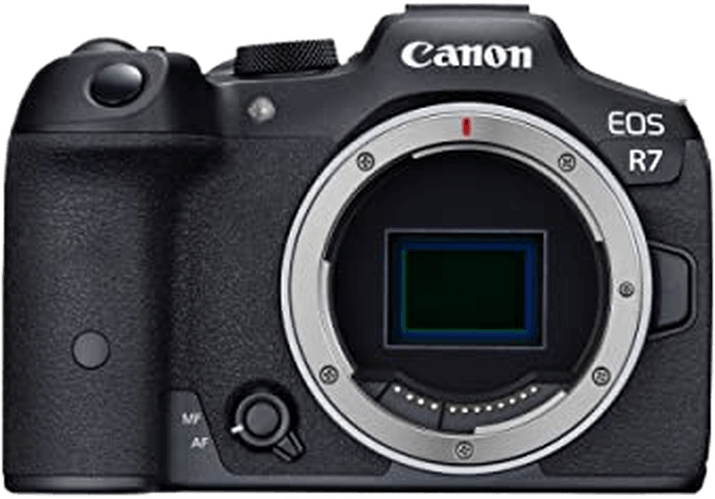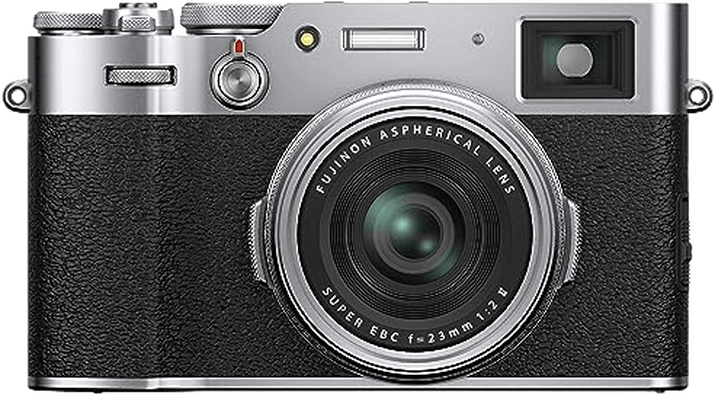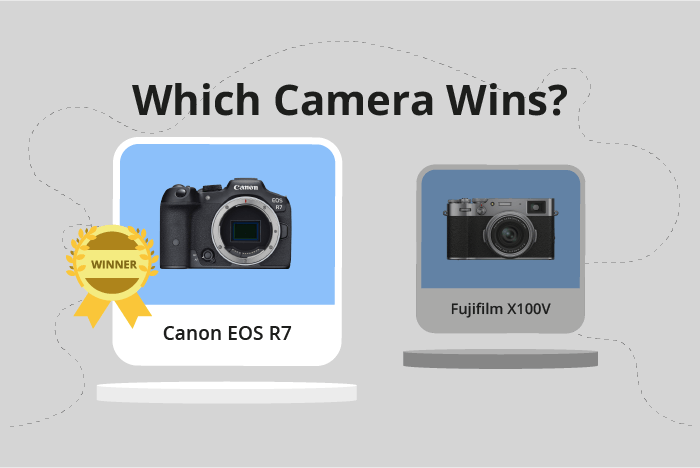Canon EOS R7 vs Fujifilm X100V Comparison
Canon EOS R7

Fujifilm X100V

The Canon EOS R7 outperforms the Fujifilm X100V with a score of 83/100 compared to 69/100. Both cameras are mirrorless and were released in 2022 and 2020, respectively. They share similarities in their launch prices, with the EOS R7 priced at $1500 and the X100V at $1399.
The EOS R7 excels with its larger size (132 x 90 x 92mm) and heavier weight (612g / 1.35lbs), providing better stability for photography. On the other hand, the Fujifilm X100V has a more compact size (128 x 75 x 53mm) and lighter weight (478g / 1.05lbs), making it more portable and convenient for on-the-go shooting.
Taking these factors into account, the Canon EOS R7 is the superior camera in terms of performance and stability, while the Fujifilm X100V offers advantages in portability and convenience.
Canon EOS R7 vs Fujifilm X100V Overview and Optics
The Canon EOS R7 wins the optics comparison with a score of 82/100, while the Fujifilm X100V scores 66/100. Both cameras share some common specifications, such as an APS-C sensor size and a CMOS sensor type. However, there are significant differences that make the Canon EOS R7 superior in terms of optics.
The Canon EOS R7 has a higher megapixel count at 33 compared to the Fujifilm X100V’s 26. This results in sharper and more detailed images. Furthermore, the Canon EOS R7 boasts a faster shooting speed of 15 frames per second compared to the 11 frames per second offered by the Fujifilm X100V, making it more suitable for capturing fast-moving subjects. The Canon EOS R7 also features a more advanced image processor, the Digic X, which allows for better image quality and processing speeds.
One major advantage of the Canon EOS R7 is its lens mount, the Canon RF, which provides the flexibility to change lenses. The Fujifilm X100V, on the other hand, has a fixed lens mount, meaning users are limited to the built-in lens. Additionally, the Canon EOS R7 offers image stabilization, while the Fujifilm X100V does not, making the former better at capturing images with minimal blur, especially in low-light conditions.
The Fujifilm X100V does not have a DXOMARK score, as the platform does not score Fujifilm cameras. However, the Canon EOS R7 has a respectable DXOMARK score of 97 for its sensor, indicating a high-quality sensor.
The Canon EOS R7 outperforms the Fujifilm X100V in optics due to its higher megapixel count, faster shooting speed, more advanced processor, flexible lens mount, and image stabilization. While the Fujifilm X100V is a good camera, the Canon EOS R7’s superior specifications make it the better choice for photographers who prioritize optics.
Canon EOS R7 vs Fujifilm X100V Video Performance
The Canon EOS R7 and the Fujifilm X100V both have a video score of 91/100, making them equal in terms of video capabilities. They share several common features, including a maximum video resolution of 4K, a maximum video frame rate of 120fps, and built-in time-lapse functionality.
The Canon EOS R7 stands out with its video dimensions of 3840 x 2160, providing high-quality video recording. This feature is ideal for those looking to capture professional-grade videos or for use in a variety of settings, such as events, sports, or nature videography. The EOS R7’s video capabilities make it a strong contender for those seeking top-notch video performance.
On the other hand, the Fujifilm X100V has slightly larger video dimensions at 4096 x 2160, giving it an edge in terms of video quality. This difference in dimensions could be beneficial for filmmakers or videographers who require a higher level of detail in their footage. The X100V’s video capabilities are also impressive and cater to the needs of professionals and enthusiasts alike.
While both cameras excel in video capabilities, the choice between the Canon EOS R7 and the Fujifilm X100V ultimately depends on individual preferences and requirements. The EOS R7 offers great video performance, making it suitable for a wide range of applications. Meanwhile, the X100V’s slightly larger video dimensions may appeal to those seeking a higher level of detail in their footage. Both cameras are excellent choices for capturing high-quality video, and users should consider their specific needs when deciding which camera best suits their needs.
Canon EOS R7 vs Fujifilm X100V Features and Benefits
The Canon EOS R7 and Fujifilm X100V both have a feature score of 85/100, indicating that they are evenly matched in terms of their capabilities. These cameras share several specifications, making them comparable in many ways.
Both cameras have a 3-inch screen with a resolution of 1,620,000 dots, ensuring clear and sharp image previews. They also come with touchscreens and flip screens, providing flexibility and ease of use for various shooting situations. Neither camera has GPS, but they both have WIFI and Bluetooth connectivity, allowing for easy sharing and transferring of images.
Despite their identical feature scores, certain aspects of the Canon EOS R7 may be more appealing to some users. For instance, Canon has a larger lens selection, offering more versatility and creative options for photographers. Additionally, the EOS R7 may have a more familiar interface and menu system for those who have used Canon cameras before.
On the other hand, the Fujifilm X100V may be more attractive to those who appreciate its retro design and compact size. Furthermore, Fujifilm is known for its unique color profiles and film simulations, which can give images a distinct and pleasing look straight from the camera.
Ultimately, the choice between these two cameras depends on individual preferences and needs. The Canon EOS R7 offers versatility in lens options and may be more familiar to some users, while the Fujifilm X100V provides a compact design and unique color profiles. Both cameras are strong contenders, and their equal feature scores reflect their impressive capabilities.
Canon EOS R7 vs Fujifilm X100V Storage and Battery
The Canon EOS R7 outperforms the Fujifilm X100V in storage and battery, boasting a score of 79/100 compared to the X100V’s 37/100. Both cameras share common specifications, such as accepting SD/SDHC/SDXC memory cards and offering USB charging.
The EOS R7 excels with its two memory card slots and compatibility with faster UHS-II cards, providing users with increased storage capacity and improved performance. Additionally, the R7’s battery life of 660 shots surpasses the X100V’s 420 shots, and its LP-E6NH battery type ensures reliability.
On the other hand, the X100V has a single memory card slot and is only compatible with UHS-I cards, limiting its storage potential and speed. Its NP-W126S battery type and shorter battery life of 420 shots make it less competitive compared to the EOS R7.
Considering these aspects, the Canon EOS R7 offers superior storage capacity and battery performance, making it a more suitable choice for photographers who require extended shooting sessions and efficient storage solutions. The Fujifilm X100V, though inferior in these aspects, still provides satisfactory performance for casual users and those who prioritize compactness over storage and battery capabilities.
Canon EOS R7 vs Fujifilm X100V – Our Verdict
Are you still undecided about which camera is right for you? Have a look at these popular comparisons that feature the Canon EOS R7 or the Fujifilm X100V:

